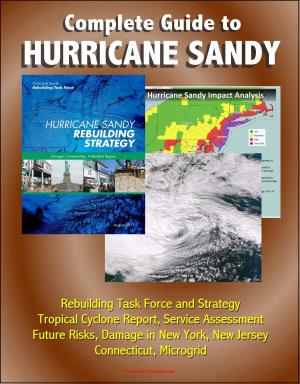Wildland Fire in Ecosystems: Effects of Fire on Soil and Water (Rainbow Series) - Wildfires and Ecosystems, Soil Chemistry, Biology, Hydrologic Cycle, Watersheds, Streamflows, Aquatic Biota, Wetlands
Nonfiction, Science & Nature, Technology, Fire Science, Science, Biological Sciences, Ecology| Author: | Progressive Management | ISBN: | 9781310468636 |
| Publisher: | Progressive Management | Publication: | December 1, 2014 |
| Imprint: | Smashwords Edition | Language: | English |
| Author: | Progressive Management |
| ISBN: | 9781310468636 |
| Publisher: | Progressive Management |
| Publication: | December 1, 2014 |
| Imprint: | Smashwords Edition |
| Language: | English |
This state-of-knowledge review about the effects of fire on soils and water can assist land and fire managers with information on the physical, chemical, and biological effects of fire needed to successfully conduct ecosystem management, and effectively inform others about the role and impacts of wildland fire. Chapter topics include the soil resource, soil physical properties and fire, soil chemistry effects, soil biology responses, the hydrologic cycle and water resources, water quality, aquatic biology, fire effects on wetland and riparian systems, fire effects models, and watershed rehabilitation.
Keywords: ecosystem, fire effects, fire regime, fire severity, soil, water, watersheds, rehabilitation, soil properties, hydrology, hydrologic cycle, soil chemistry, soil biology, fire effects models
The Rainbow Series emphasizes principles and processes rather than serving as a summary of all that is known. However, it does provide a lot of useful information and sources for more detailed study of fire effects. The five volumes, taken together, provide a wealth of information and examples to advance understanding of basic concepts regarding fire effects in the United States and Canada. While this volume focuses on the United States and Canada, there are references to information and examples from elsewhere in the world (e.g. Australia, South Africa, Spain, Zimbabwe, and others) to support the statements made. As conceptual background, they provide technical support to fire and resource managers for carrying out interdisciplinary planning, which is essential to managing wildlands in an ecosystem context. Planners and managers will find the series helpful in many aspects of ecosystem-based management, but they also have the responsibility to seek out and synthesize the detailed information needed to resolve specific management questions.
Chapter 1 - Introduction * Importance of Fire to Soil and Water * Scope * Fire Regimes * Fire Severity * Fire Intensity versus Fire Severity * Fire Intensity Measures * Depth of Burn Measures * Fire Severity Classification * A Conceptual Model * Fire-Related Disturbances * Fire * Fire Suppression * Type of Effects * This Book's Objective * Part A * Effects of Fire on Soil * Part A: The Soil Resource: Its Importance, Characteristics, and General Responses to Fire * The General Nature of Soil * Soil Properties: Characteristics, Reactions, and Processes * Soil Profile * Importance of Organic Matter * Fire Effects: General Concepts and Relationships * Severity and Fire Intensity * Combustion * Heat Transfer * Depth and Magnitude of Soil Heating * Temperature Thresholds of Soil Properties * Location of Soil Properties * Assessing Fire Effects on Soils * Management Implications * Summary * Chapter 2 * Soil Physical Properties * Soil Physical Characteristics * Soil Texture and Mineralogy * Soil Structure * Bulk Density and Porosity * Physical Processes * Heat Transfer in Soils * Water Repellency * Soil Erosion * Processes and Mechanics * Postfire Sediment Yields * Management Implications * Summary * Chapter 3 * Soil Chemistry * Introduction Soil Chemical Characteristics * Organic Matter and Carbon * Cation Exchange Capacity * Cations * Soil pH and Buffer Capacity * Nitrogen * Phosphorus * Sulfur * Soil Chemical Processes * Nutrient Cycling * Nutrient Loss Mechanisms * Nutrient Availability * Ash-Bed Effect * Management Implications * Summary * Chapter 4 * Soil Biology * Biological Components of Soils * Soil Microorganisms * Soil Meso- and Macrofauna * Roots and Reproductive Structures * Amphibians, Reptiles, and Small Mammals * Biologically Mediated Processes in Soils * Decomposition and Mineralization * Nitrogen Cycling Processes * Fire Effects on Organisms and Biological Processes * Soil Microorganisms * Soil Meso- and Macrofauna * Roots and Reproductive Structures * Amphibians, Reptiles, and Small Mammals
This state-of-knowledge review about the effects of fire on soils and water can assist land and fire managers with information on the physical, chemical, and biological effects of fire needed to successfully conduct ecosystem management, and effectively inform others about the role and impacts of wildland fire. Chapter topics include the soil resource, soil physical properties and fire, soil chemistry effects, soil biology responses, the hydrologic cycle and water resources, water quality, aquatic biology, fire effects on wetland and riparian systems, fire effects models, and watershed rehabilitation.
Keywords: ecosystem, fire effects, fire regime, fire severity, soil, water, watersheds, rehabilitation, soil properties, hydrology, hydrologic cycle, soil chemistry, soil biology, fire effects models
The Rainbow Series emphasizes principles and processes rather than serving as a summary of all that is known. However, it does provide a lot of useful information and sources for more detailed study of fire effects. The five volumes, taken together, provide a wealth of information and examples to advance understanding of basic concepts regarding fire effects in the United States and Canada. While this volume focuses on the United States and Canada, there are references to information and examples from elsewhere in the world (e.g. Australia, South Africa, Spain, Zimbabwe, and others) to support the statements made. As conceptual background, they provide technical support to fire and resource managers for carrying out interdisciplinary planning, which is essential to managing wildlands in an ecosystem context. Planners and managers will find the series helpful in many aspects of ecosystem-based management, but they also have the responsibility to seek out and synthesize the detailed information needed to resolve specific management questions.
Chapter 1 - Introduction * Importance of Fire to Soil and Water * Scope * Fire Regimes * Fire Severity * Fire Intensity versus Fire Severity * Fire Intensity Measures * Depth of Burn Measures * Fire Severity Classification * A Conceptual Model * Fire-Related Disturbances * Fire * Fire Suppression * Type of Effects * This Book's Objective * Part A * Effects of Fire on Soil * Part A: The Soil Resource: Its Importance, Characteristics, and General Responses to Fire * The General Nature of Soil * Soil Properties: Characteristics, Reactions, and Processes * Soil Profile * Importance of Organic Matter * Fire Effects: General Concepts and Relationships * Severity and Fire Intensity * Combustion * Heat Transfer * Depth and Magnitude of Soil Heating * Temperature Thresholds of Soil Properties * Location of Soil Properties * Assessing Fire Effects on Soils * Management Implications * Summary * Chapter 2 * Soil Physical Properties * Soil Physical Characteristics * Soil Texture and Mineralogy * Soil Structure * Bulk Density and Porosity * Physical Processes * Heat Transfer in Soils * Water Repellency * Soil Erosion * Processes and Mechanics * Postfire Sediment Yields * Management Implications * Summary * Chapter 3 * Soil Chemistry * Introduction Soil Chemical Characteristics * Organic Matter and Carbon * Cation Exchange Capacity * Cations * Soil pH and Buffer Capacity * Nitrogen * Phosphorus * Sulfur * Soil Chemical Processes * Nutrient Cycling * Nutrient Loss Mechanisms * Nutrient Availability * Ash-Bed Effect * Management Implications * Summary * Chapter 4 * Soil Biology * Biological Components of Soils * Soil Microorganisms * Soil Meso- and Macrofauna * Roots and Reproductive Structures * Amphibians, Reptiles, and Small Mammals * Biologically Mediated Processes in Soils * Decomposition and Mineralization * Nitrogen Cycling Processes * Fire Effects on Organisms and Biological Processes * Soil Microorganisms * Soil Meso- and Macrofauna * Roots and Reproductive Structures * Amphibians, Reptiles, and Small Mammals















